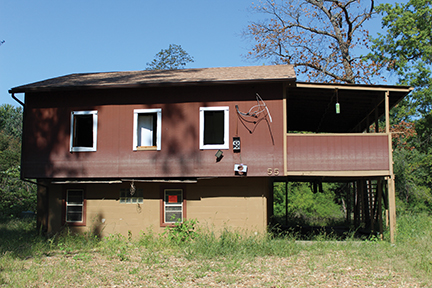
In Orchard Farm and surrounding communities, evidence of this spring’s monster flood is both everywhere and nowhere. The water line is still visible on many homes, some of which bear orange stickers that designate the insurance company’s order to raise the home. However, in other spots, the impact of the recent devastation hides under vibrant leaves of beans, which have taken over fields recently covered by water.

The problem with the field of beans is that these plants are not thriving. For starters, they should be much taller. After a flood, farmers have to choose from a variety of bad choices. There’s approximately a ten percent chance of yielding profit from “late beans,” as farmers call them. The best time of year to plant these beans is around April. Most of the beans growing in and around Orchard Farm were planted in July, when the flood water relinquished the soil. To the naked eye, the fields look great. But the reality is that the hardships created by recent flooding are still flowing through the community, sometimes invisible to the naked eye. Other signs of the ongoing recovery are obvious, like the closed post office and library int he nearby town of Portage des Sioux.

Another member of Trinity Lutheran Church, Steve Schade, has been displaced from his home since March 15, 2019. He had water in the second story of his house, which was adjacent to a duck hunting club he helped manage. After the water receded, they were unable to plant the corn that would typically attract the ducks. Instead, they hired some aerial planters to drop Japanese millet, which they would be able to grow in the truncated time until duck season.
Mr. Schade has been fortunate to find a new property, one still close to the duck club. He has had a positive experience decorating it with rustic furniture and other pieces that reflect his love of nature and hunting. Despite the bright spots, there is still a long road ahead to recovery. For people with coverage, insurance companies are notoriously difficult to work with and even if people have the means to rebuild their homes or find a new one, some will have to move away due the distinct housing shortage created by the flood. He knows many people who have not yet found a new home, as well as many farmers who will be dealing with the aftermath of this flood for years to come.

The Missouri District has been collecting and distributing donations to victims of this historic flooding. In Orchard Farm, Trinity Lutheran Church used district-allocated dollars to rent storage pods and fill them with cleaning supplies. With the assistance of the local media, they let the community know that the supplies were available to anyone in need, free of charge. Upon arrival, families had the option to request a visit from the pastor, which a handful of people requested.
Ms. Wehmeyer said that people were sometimes uncomfortable needing to ask for help. But in the aftermath of a flood, the supplies they were offering included bleach, mold killing chemicals, plastic spray cans, squeegees, paper towels, and were an absolute necessity. She offered them insights from a sermon she heard back in the great flood of ’93. She told them, “Sometimes you have to be the one asking for help, so other people can experience the joy of giving.” These words echoing from a thousand Sundays ago added additional comfort to this ministry.
